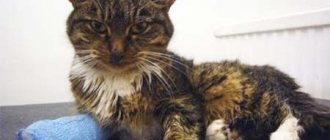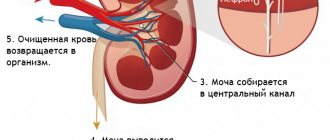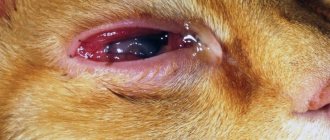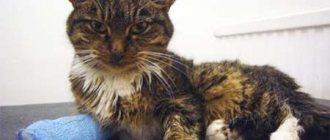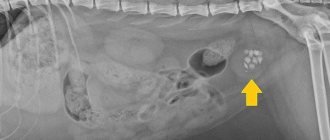Learn now about the symptoms and treatments for kidney disease in cats, such as kidney failure, pyelonephritis and glomerulonephritis.
Veterinarians often diagnose cats with kidney disease. Due to their anatomical features, the kidneys are the weak point of these animals. Adding to the problem is the ability of cats to drink little and go without water for long periods of time. To reduce the risk of kidney pathologies, the cat owner should ensure that the pet always has fresh water. Especially those who receive dry food. Any malfunction in the functioning of this paired organ is dangerous for the cat’s health and can threaten the pet’s life.
In this material we will present the main causes of kidney disease and tell you what signs should alert cat owners. We will answer questions about how kidney pathologies are diagnosed and what methods are used to treat these diseases. We will select the optimal diet for sick animals and suggest methods of prevention.
Symptoms
The kidneys in cats perform several important functions, the main one of which is the removal of water and water-soluble substances from the body. In addition, they cleanse the blood and participate in metabolic processes. Therefore, the first thing the owner needs to pay attention to is the frequency of urination and the volume of urine. If your cat goes to the toilet too often and urinates past the litter tray without having time to reach the toilet, take the animal to the doctor.
What other signs indicate that a cat has diseased kidneys?
- Too infrequent urination and its complete absence also indicate kidney pathologies.
- Excessive thirst is the animal’s body’s response to increased frequency of urination. This is how cats try to replenish the lost volume of fluid.
- Weakness and lethargy. Dehydration is bad for your pet. Cats avoid active games and lie and sleep a lot.
- Decreased appetite and complete refusal to eat. Sick cats feel unwell, their appetite decreases, and the animals lose weight.
- Nausea and vomiting with bile. Possible in animals with renal failure.
- The presence of blood impurities in the cat’s urine. Often indicates ICD.
- Arterial hypertension.
- Bad breath.
- Deterioration of coat condition.
- Anemia.
Important!
If your pet exhibits one or more of these signs, do not hesitate to contact your veterinarian.
Symptoms of pyelonephritis
The animal begins to develop a fever and has difficulty urinating. The pet urinates often and painfully, while emitting a plaintive meow. The cat is lethargic, with low activity, and often shows aggression towards its owner. The presence of acute pain in the lumbar region.
When a cat is sick, it urinates frequently and painfully.
Purulent pyelonephritis is manifested by increased thirst and weakness. Severe vomiting begins and appetite disappears. This phenomenon is fraught with serious consequences, including complete kidney failure.
Establishing diagnosis
To make a diagnosis, urine is collected.
- The diagnosis is made based on anamnesis, urine and blood are collected for laboratory testing.
- Ultrasound examination of the lumbar region and abdominal cavity.
Common Causes of Kidney Disease in Cats
Let us list the main reasons leading to disturbances in kidney function.
Dietary:
- Unbalanced diet (excessive consumption of protein, phosphorus, salts).
- Insufficient water intake when feeding dry food.
Traumatic:
- Falling from height.
- Getting hit by a car.
- Hypothermia, frostbite.
- Heatstroke.
- Compression of the ureters by tumors.
Infectious:
- Bacterial infections.
- Viral diseases.
- Undertreated and neglected diseases of the genitourinary system.
Poisoning:
- Rat poisons.
- Chemicals.
- Detergents
- Medicines.
Congenital:
- Renal dysplasia (developmental pathology).
- Renal aplasia (absence of one or two kidneys).
Risk group
Those at risk for kidney pathology are:
- Elderly cats and cats. By the age of 9 years, the likelihood of this type of disease increases by 2 times.
- Cats that are obese and lead an inactive lifestyle.
- Representatives of some breeds: Abyssinian, Somali, Himalayan, Persian cats and exotics.
- Animals kept in damp rooms and drafts.
- Underweight cats, starving animals.
What is pyelonephritis?
Pyelonephritis is an inflammation of the kidney tissue, affecting mainly the pelvis, calyces and parenchyma. In the absence of timely treatment, the inflammatory process spreads to the blood vessels and renal glomeruli. As a rule, the disease is provoked by a bacterial infection that penetrates the kidneys through an ascending or descending (hematogenous) route. Often the cause of the disease is stagnation of urine in the pelvis, penetration of pathogenic microorganisms from the urethra or genitals, and parasites. The following types of pyelonephritis are distinguished (by form):
- hemorrhagic - develops as a result of fragility of the blood vessels in the kidneys;
- catarrhal - an acute form of the disease, easily treatable;
- purulent - a severe form of the disease, characterized by the accumulation of pus in the kidney tissue.
According to the nature of the disease, there are 2 types of disease - acute and chronic. The latter appears as a result of untimely treatment of the acute form and is characterized by periods of remission and periodic exacerbations throughout life. According to the etiology, pyelonephritis can be primary (when the infection occurs in the kidneys) and secondary, in which bacteria migrate into the kidney tissue from other organs through the bloodstream.
Diagnostics
To diagnose kidney pathologies, veterinarians resort to a number of studies. First, blood and urine tests are done to assess the concentration of substances that are normally filtered by healthy kidneys.
In addition, the doctor may prescribe:
- Ultrasound of the abdominal cavity;
- fluoroscopic examination;
- urine culture;
- biopsy.
Important!
Kidney pathologies are serious diseases that require early diagnosis - do not delay a visit to the veterinarian!
Vesico-ureteral reflux
Vesico-ureteral reflux is a pathological condition characterized by the backflow of a small amount of urine into the renal pelvis. It is caused by its obstructed outflow into the bladder through the ureters.
Vesico-ureteral reflux is most often diagnosed in childhood and adolescence. Its danger lies in an acute attack with painful symptoms and quickly occurring complications. It is in childhood that there is a high risk of rapid replacement of functionally active tissues with connective tissues with pathological scarring. A number of factors predispose to pyelonephritis, including anatomical features:
- lower hydrostatic pressure (the volume of blood flowing through the kidney);
- inability to control urination in early childhood;
- lack of intimate hygiene skills;
- predisposition to weakened immunity.
Young children do not inform their parents about the first uncomfortable sensations and do not know how to interpret them. Therefore, pyelonephritis is diagnosed in them not at an early stage, but at a late stage, when severe complications have already arisen.
Another feature of the development of the disease in childhood and adolescence is the descending route of infection. Pathogenic microorganisms are transported by the blood stream from inflammatory foci formed in the upper respiratory tract. There are known cases where the trigger for pathology was carious teeth and a common ARVI.
Classification of kidney diseases
Based on the location of the primary pathological process, kidney diseases are divided into:
- Primary.
- Secondary.
The first group includes diseases in which the pathological process began directly in the kidneys. The second group included kidney damage as a result of hypertension, diabetes, and diseases of the genitourinary system.
According to the nature of the disease, the following are distinguished:
- Acute;
- Chronic.
In addition, congenital and acquired diseases are distinguished. Congenital - the result of genetic disorders in certain breeds of cats. The risk group includes Somali, Persian, Abyssinian and Himalayan breeds.
Preventive measures
The main rule that will help avoid the occurrence of pyelonephritis in a cat is timely treatment of any diseases. Infection of the renal pelvis can be caused by gynecological, colds, as well as problems with the animal’s genitourinary system. Therefore, it is very important to contact a veterinarian at the first signs of illness. In addition, an important condition for preventing pyelonephritis is keeping the cat warm and dry. You should regularly take the animal for a walk and provide it with a balanced diet, which will contain a sufficient amount of vitamins and minerals for the normal functioning of the body.
By bringing a cat into the house, the owner obliges himself to take care of it. The main manifestation of care is attention to your pet, thanks to which you can notice the disease in the early stages and quickly get rid of it without consequences for the small furry creature.
Major kidney diseases in cats
Nephritis in cats
The most common kidney diseases in cats are inflammatory nephritis, which, depending on the location and nature, is divided into pyelonephritis and glomerulonephritis.
Pyelonephritis
This is an inflammation of the renal pelvis and tissue (parenchyma) of the kidney, most often of bacterial origin. The pathology is usually secondary in nature, occurring after infection of the genital organs, stagnation of urine, urolithiasis, inflammation of the bladder and hypothermia.
It can be acute or chronic. The acute form of the disease is dangerous for cats and can lead to kidney failure and death. The death of the animal can occur within 12 hours.
Important!
The insidiousness of pyelonephritis lies in the fact that the symptoms, at the onset of the disease, can manifest themselves extremely weakly.
Causes
The causes of this disease are untreated cystitis, infection, hypothermia, advanced pathologies of the genitourinary system, attacks of the kidneys by opportunistic organisms (staphylococci, streptococci, E. coli). Less often – genetic nature or old age of the animal.
Symptoms of acute pyelonephritis
- a sharp increase in temperature;
- fever, chills;
- increased thirst;
- increased frequency and amount of urine when urinating;
- cloudiness of urine and the presence of blood impurities in it;
- painful sensations when palpating the kidneys;
- the animal meows pitifully when urinating (painful sensations).
Symptoms of chronic pyelonephritis
- thick discharge from the genitals;
- exhaustion;
- change in urination pattern;
- with exacerbation of the chronic process, signs characteristic of acute pyelonephritis appear.
Diagnostics
- collecting anamnesis and examining the animal;
- general blood analysis;
- Analysis of urine.
Treatment
- antibiotic therapy;
- diuretics;
- painkillers;
- antispasmodics;
- compliance with the drinking regime;
- diet therapy with reduced amounts of protein and phosphorus.
Prevention
- promptly and efficiently treat diseases of the genitourinary system;
- prevention of urolithiasis;
- monitor your drinking regime;
- provide complete, balanced nutrition;
- keep animals in clean, warm, draft-free rooms;
- prevent pets from hypothermia.
Glomerulonephritis
This is a non-infectious disease that causes damage to the structural units (glomeruli) of the kidneys - nephrons. It occurs acutely, subacutely and chronically.
Causes
As a rule, this disease develops as a result of previous diseases:
- purulent inflammation of the uterus in cats;
- liver inflammation;
- various allergic lesions;
- pyelonephritis;
- injuries
It may also be a consequence of hypothermia and violation of housing and feeding conditions.
Risk factors: pet hypothermia, exposure to dampness, unsatisfactory quality of food, which leads to a decrease in the protective properties of the body.
Symptoms
- painful urination;
- hyperthermia;
- pain in the kidney area;
- presence of blood in the urine;
- decreased amount of urine;
- swelling of the veins and muzzle;
- difficulty wheezing;
- increased blood pressure;
- weakness, apathy;
- coordination problems.
Diagnostics
- blood analysis;
- Analysis of urine;
- Ultrasound of the abdominal cavity;
- ultrasound-guided kidney biopsy;
- fundus examination (for the presence/absence of blood spots);
- X-ray of the lungs (determines the presence/absence of water in the lung area).
Treatment
- diet therapy;
- a course of antibiotics;
- corticosteroid (hormonal) therapy;
- painkillers;
- vitamin therapy;
- sulfa drugs;
- aminoglycosides.
An important part of treatment is the creation of high-quality conditions for keeping the pet. The cat is placed in a warm, clean, draft-free room. The animal is not allowed outside.
Prevention
- control of body weight and blood pressure;
- comfortable living conditions;
- high-quality balanced nutrition;
- compliance with the drinking regime;
- regular (at least once every six months) preventive examinations by a veterinarian;
- taking vitamin and mineral complexes.
Kidney failure in cats
This is a pathological condition that is characterized by disruption of all kidney functions. The nephrons of the kidneys are progressively destroyed and replaced by connective tissue. This leads to serious and irreversible metabolic disorders. Can be acute or chronic. Chronic renal failure is an incurable pathology. The therapy is aimed at prolonging the cat’s life and improving its quality.
Causes
Renal failure can develop in case of poisoning, heat stroke, bleeding, pyelonephritis and glomerulonephritis, and compression of the ureters by a tumor. Most often, renal failure occurs as a complication after urolithiasis, pyelonephritis, glomerulonephritis, amyloidosis and neoplasia.
Symptoms
- deterioration in wool quality;
- weight loss;
- increased thirst;
- frequent or absent urination;
- blood in urine;
- vomit;
- diarrhea;
- weakness and apathy;
- depressed state;
- increased heart rate;
- swelling and pallor of the mucous membranes.
Diagnostics
- blood test (for urea nitrogen and creatinine);
- urine test (for protein).
Important!
Diagnosis and treatment of acute and chronic renal failure is only within the competence of a veterinarian.
Treatment
- diet therapy - a diet low in protein and phosphorus;
- a course of antibiotics;
- potassium preparations;
- a course of vitamins B and C;
- drugs to lower blood pressure;
- antiemetics;
- Iron supplements for cats with anemia.
The disease cannot be completely cured, but you can extend your pet’s life by several years and improve its quality.
Prevention
- timely vaccination;
- regular preventive examinations;
- High-quality balanced nutrition;
- timely treatment of all diseases of the genitourinary system.
Video:
Nephrolithiasis (kidney stone disease)
Kidney stone disease is characterized by the accumulation of crystalline sand and stones in the kidneys, a filtering organ. This pathology most often occurs in older cats over 7 years old. Kidney stones are less common in cats.
Causes
- congenital anomalies of the genitourinary organs;
- genetic defects (exotics, Persian cats, British shorthairs);
- errors in diet planning;
- metabolic disorders;
- urinary tract infections;
- long-term use of medications;
- endocrine diseases;
- hormonal disorders;
- avitaminosis.
Symptoms
- painful urination;
- frequent urge and urine production in small drops;
- change in urine color (brown, brown, bloody);
- changes in behavior: nervousness or lethargy;
- lack of appetite;
- frequent intermittent breathing;
- painful sensations in the abdomen, the cat does not allow itself to be touched;
- the cat sits in the tray for a long time, but the litter is dry;
- digestive disorders, nausea, vomiting.
Diagnostics
- studying the anamnesis, the owner must describe in detail all changes in the animal’s behavior, tell how long this has been happening to the pet;
- general blood test to diagnose inflammatory processes;
- blood chemistry;
- Analysis of urine;
- bacterial culture of urine;
- Ultrasound of the abdominal organs;
- fluoroscopy;
- laboratory analysis of the passed stone.
Treatment
The treatment regimen is selected individually, taking into account the condition of the animal, its age and the causes of nephrolithiasis. If kidney stones are particularly large, surgical treatment methods are used. In other cases, drug therapy is sufficient, which includes:
- therapeutic diet;
- antibiotic therapy;
- therapy that dissolves nephroliths (stones);
- hemostatic drugs;
- antispasmodics;
- droppers to restore the balance of fluids in the cat’s body;
- physiotherapy.
Prevention
- creating conditions for comfortable keeping of a cat;
- avoiding hypothermia and heat stroke;
- proper diet planning;
- obesity prevention;
- providing your pet with fresh water;
- compliance with the water regime.
Video:
Polycystic kidney disease
Polycystic disease is a pathology in which cysts gradually appear and grow in the kidneys of cats. In some breeds (exotics, Persians, Himalayan cats) this disease is hereditary.
Causes
The only cause of polycystic kidney disease identified to date is genetic predisposition.
Symptoms
Clinical signs of polycystic disease appear only in old age in cats over 7 years of age. The symptoms of the pathology are similar to kidney failure, and therefore require professional diagnosis in a veterinary clinic.
- loss of appetite and complete refusal to eat;
- depression, apathy;
- excessive thirst;
- sudden weight loss;
- gastrointestinal disorders, nausea, vomiting;
- frequent painful urination.
Diagnostics
For diagnosis, the doctor uses a set of measures:
- palpation of the abdomen in the kidney area;
- blood chemistry;
- clinical analysis of urine and feces;
- kidney biopsy;
- radiography;
- Ultrasound of the abdominal organs;
- urological culture.
Treatment
The disease is incurable. At an early stage, it is possible to surgically remove the affected area. The main therapeutic measures are aimed at improving the animal’s quality of life.
- diet low in phosphorus and protein;
- vitamin therapy (D);
- symptomatic treatment of hypertension;
- antibiotic therapy;
- hormone therapy;
- droppers to restore water balance in the body.
Prevention
- preventing individuals with diagnosed polycystic disease from mating;
- timely vaccination;
- minimizing infectious diseases;
- regular preventive examinations.
Video:
Nephrosclerosis
The pathology, which has the second name “wrinkled kidney,” is characterized by the replacement of healthy kidney tissue with connective tissue. This leads to the loss of all functions of the organ. Cure is possible only at an early stage of the disease; in advanced cases, the animal cannot be saved. The difficulty lies in the fact that the clinical picture at the onset of the disease is blurred and resembles other pathologies.
Causes
- chronic hypertension leading to glomerular ischemia;
- atherosclerosis;
- diabetes;
- nephrosis in an advanced stage;
- glomerulonephritis;
- leptospirosis.
Symptoms
- sudden increase in body temperature, fever, chills;
- high blood pressure;
- hematuria (blood in the urine);
- painful urination;
- visual impairment;
- change in frequency of urination;
- weight loss;
- increased thirst.
Diagnostics
- general clinical analysis of blood and urine;
- Ultrasound of the kidneys, liver and gastrointestinal tract;
- fundus examination;
- blood pressure measurement;
- scintigraphy;
- auscultation of the heart;
- CT scan.
Treatment
The disease is incurable. Veterinarians prescribe symptomatic therapy to sick animals.
- diuretics;
- drugs to lower blood pressure;
- drip infusion of glucose preparations;
- diet therapy;
- cardiac drugs.
Prevention
Prevention of nephrosclerosis comes down to the prevention and timely treatment of acute kidney damage, avoiding cases of poisoning and intoxication.
Hydronephrosis
The second name of the pathology is hydrocele of the kidney. The disease is characterized by a violation of the outflow of urine due to narrowing of the urinary tract. The diseased organ stretches and its tissues die.
Causes
- inflammatory diseases of the genitourinary area;
- neoplasms in the kidneys;
- adhesions;
- prostate atrophy;
- ICD;
- surgical operations on internal organs;
- injuries.
Symptoms
- visual increase in the size of the abdomen;
- hyperthermia (increased body temperature);
- difficulty urinating or lack thereof;
- loss of appetite, refusal to eat;
- blood impurities in the urine.
Diagnostics
- blood analysis;
- Analysis of urine;
- Ultrasound of the kidneys;
- urography.
Treatment
Treatment measures are aimed at eliminating the causes that impede the flow of urine. In some cases, amputation of the diseased organ may be necessary. Bilateral hydronephrosis is incurable and fatal.
Prevention
- compliance with the water regime;
- water quality control;
- low salt diet;
- preventing hypothermia;
- control of body weight, prevention of obesity;
- vitaminization;
- timely dental treatment.
Amyloidosis
The pathology is characterized by disturbances in protein-carbohydrate metabolism, as a result of which amyloid (a protein-polysaccharide compound) is deposited in the kidney tissue. The disease is genetic in nature and most often occurs in Abyssinian and Somali Oriental and Siamese cat breeds. It occurs in acute and chronic forms. In its advanced form, the kidneys fail, which leads to death.
Causes
- hereditary predisposition;
- past infectious diseases;
- poisoning;
- Vitamin A hypervitaminosis.
Symptoms
At the early stage of the disease, clinical signs are not pronounced. As the disease progresses, the following symptoms appear:
- frequent urination;
- loss of appetite and refusal to eat;
- sudden weight loss to the point of exhaustion;
- vomit;
- excessive thirst;
- decreased activity due to joint pain;
- swelling of the face and paws;
- depressed state;
- yellowness of the mucous membranes and skin;
- diarrhea, pale stools;
- darkening of urine.
Diagnostics
- laboratory urine test;
- fluoroscopy of the kidneys;
- kidney biopsy;
- Ultrasound of the abdominal organs;
- general and biochemical analysis of the kidneys.
Treatment
The disease cannot be treated. Maintenance therapy is aimed at prolonging and improving the quality of life of a sick pet. The cat's diet must be reviewed. In some cases, they resort to removing the diseased organ.
Prevention
There is no specific prevention. The cat needs comfortable living conditions and high-quality balanced nutrition, regular preventive examinations and timely deworming.
Congenital malformations
In addition to the above diseases, congenital anomalies of kidney development may occur in cats:
- Renal aplasia. A pathology in which an animal is missing one or two kidneys.
- Renal dysplasia. A congenital defect in which the paired organ develops incorrectly.
Both of these conditions can lead to kidney failure and death of the animal.
Varieties
Nephritis in cats is classified primarily by the speed of its progression. In this regard, a distinction is made between acute and chronic forms of the disease. According to localization, this disease can be focal or diffuse. According to the degree of tissue damage, they are distinguished:
- glomerulonephritis, in which the kidney glomeruli begin to deteriorate and gradually die;
- pyelonephritis – stage of purulent inflammation of the renal pelvis;
- interstitial nephritis, in which the tubules become inflamed and urine infiltration occurs.
The latter type of pathology in cats is quite rare. Against the background of glomerulonephritis, an animal, among other things, may develop a lipoid form of the disease, accompanied by the replacement of kidney tissue with fatty structures and their degeneration. This pathological process is very severe and is considered incurable.
What are the dangers of kidney disease in cats?
The serious danger of kidney diseases is that many of them can develop and progress for years without a clear clinical picture. Some occur in a latent form, while others show vague signs. This prevents owners from sounding the alarm in a timely manner and veterinarians from diagnosing a serious illness.
Disturbances in the functioning of the kidneys are painless for the animal. The healthy part of the kidney takes on the load from the diseased area. Up to a certain point, the paired organ copes with the pathology on its own. When the kidneys can no longer cope with the increased load, the first symptoms appear. Usually by this time most of the animal’s organ has irretrievably died and it cannot be saved.
Important!
To promptly identify kidney pathologies, undergo a full preventive examination by a veterinarian once every six months.
Difference between nephritis and pyelonephritis
- Nephritis occurs when damage occurs directly in the paired organs themselves, that is, blood circulation and the function of its purification are disrupted.
- Pyelonephritis occurs when the adrenal glands, kidneys and urinary tract are damaged.
Pyelonephritis occurs when the kidneys are damaged.
In other words, the development of the latter impairs urinary function and impairs the function of urine output.
Hence the conclusion - pyelonephritis is an inflammatory disease of the renal pelvis, provoked by bacteria.
Types of pyelonephritis
- According to the type of origin, it can be catarrhal, hemorrhagic and purulent process.
- According to the type of course - acute and chronic illness.
- But also according to the factors of occurrence - primary and secondary process.
Kidney with pyelonephritis.
Primary pathology usually develops in the organs themselves. Secondary origin affects the bladder and urinary tract, preceded by either a functional or organic disorder.
Feeding cats with kidney disease
For all kidney diseases, a therapeutic diet is prescribed. Properly selected food can prolong a cat’s life and improve its quality. Only a doctor prescribes a diet for sick animals - experiments in such a serious matter can lead to a sad outcome.
Veterinarians usually recommend switching the animal to ready-made medicated food. It is difficult to create a menu from natural products that will meet the needs of a sick cat.
Recommended brands of food:
- Eukanuba Renal;
- Clan Vet RENAL;
- Hill's Prescription Diet K/D Feline Renal Health;
- Brid VDC Renal;
- Farmina Vet Life Renal;
- Royal Canin Renal RF23;
- Pro Plan Veterinary Diets Feline UR Urinary;
- Monge Grain Free Vetsolution Renal Feline;
- Purina Veterinary Diets N;
- Sanabelle Urinary.
Infectious agents
The most common infectious agent of acute pyelonephritis is Escherichia coli. It is a gram-negative rod-shaped bacterium that lives in the lower intestine. The development of the inflammatory process can be provoked by the following microorganisms:
- staphylococci;
- Proteus;
- Klebsiella;
- enterococci;
- pseudomonas;
- streptococci;
- Pseudomonas aeruginosa.
A disease caused by the introduction of pathogenic or opportunistic fungi into the renal structures is diagnosed much less frequently.
In case of ascending infection in the urine, E. coli is especially often detected by biochemical methods or microscopy. But if surgical intervention, traumatic injury and medical manipulation led to pathology, then Klebsiella, Proteus, and Pseudomonas aeruginosa are detected.
Prevention of kidney diseases
General preventive measures:
- Proper care and comfortable maintenance of your pet.
- Avoiding hypothermia of the animal.
- Providing a balanced diet for your cat.
- Preventing falls from heights.
- Preventing the animal from walking on its own.
- Vaccination according to the vaccination schedule.
- Compliance with drinking regime.
- Water quality control.
- Organization of proper nutrition.
- Regular preventive examinations with a veterinarian.
Instrumental studies
Instrumental diagnostics are necessary not only to detect kidney damage. It is carried out to determine the localization of the pathological process, the degree of its severity, as well as factors predisposing to the development of acute pyelonephritis. The most informative results are the following instrumental studies:
- Ultrasound. Using ultrasound, it is possible to accurately assess the density of paired organs, their shape and size. Acute inflammation is indicated by abnormal values of these diagnostic criteria and an uneven decrease in echogenicity.
- CT. Computed tomography allows you to obtain an x-ray picture in the form of thin layer-by-layer sections.
- Excretory urography. A diagnostic technique aimed at examining all organs of the urinary system. They are clearly visualized on photographs due to the preliminary intravenous administration of a contrast agent.
- Cystography. The study helps to identify vesicoureteral reflux, which provokes the reverse reflux of urine. It consists of an X-ray examination of the bladder, previously filled with a contrast agent.
Differential diagnosis is also carried out to exclude pathological conditions that manifest similar symptoms, such as renal failure.
Treatment
It is strictly prohibited to treat your pet at home! If signs of pyelonephritis appear, you should immediately contact a veterinarian!
The most important thing in the treatment of kidney inflammation is antibiotics. Usually sulfonamides (urosulfan, sulfalene) or penicillins (ampicillin, amoxicillin) are used. They are prescribed in increased dosages for a course of at least 2 weeks. Then they take a break for a week, after which the course of antibiotics is repeated. There is a combination therapy - for this, bicillin is administered intramuscularly and sulfadimezin in the form of tablets in the morning. In the evening I give furodanin and tetravit subcutaneously. The course of such treatment is 10 days.
To relieve pain, antispasmodics are used - no-shpa, papaverine. And also for very severe colic, a perinephric blockade is used.
No-shpa can be given even before a trip to the veterinarian to relieve an acute attack of pain and alleviate the pet’s condition.
To improve the general condition, decoctions of herbs are prescribed, which have a diuretic and anti-inflammatory effect. For this, infusions of calendula flowers, horsetail, and rose hips are used.
With the development of a purulent form of pyelonephritis, glucocorticosteroids are used - prednisolone, hydrocartisone. Also, in order to reduce intoxication, droppers with solutions of sodium chlorine and rheopolyglucin are prescribed.
Regime and diet
The animal must be prescribed complete rest. Move the bed to a warm place without drafts. Place the sleeping place so that no one in the household disturbs the pet.
The diet should consist of easily digestible components with limited proteins. You can give fermented milk products and boiled vegetables. You can use special food for kidney disease. The animal should not limit its drinking.
